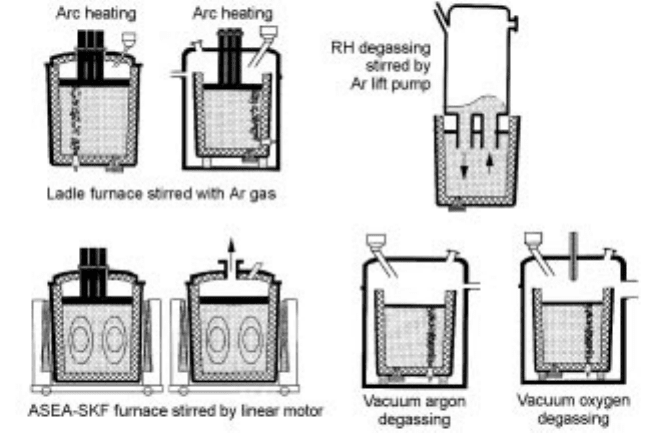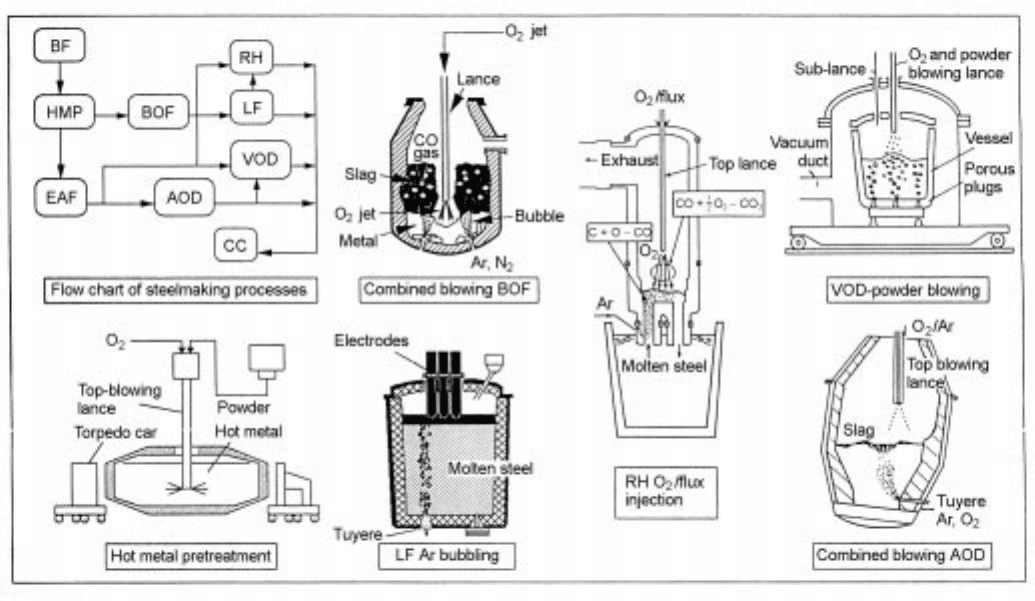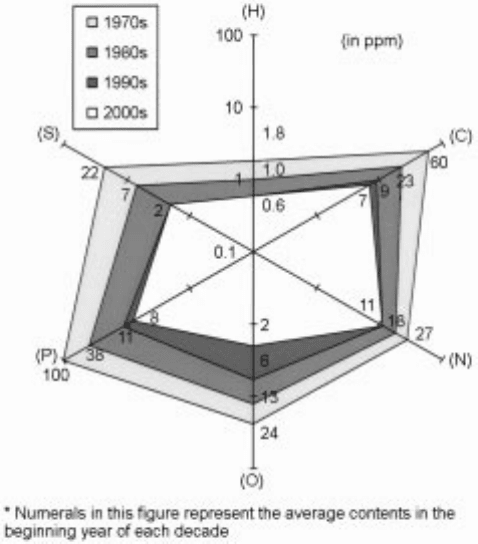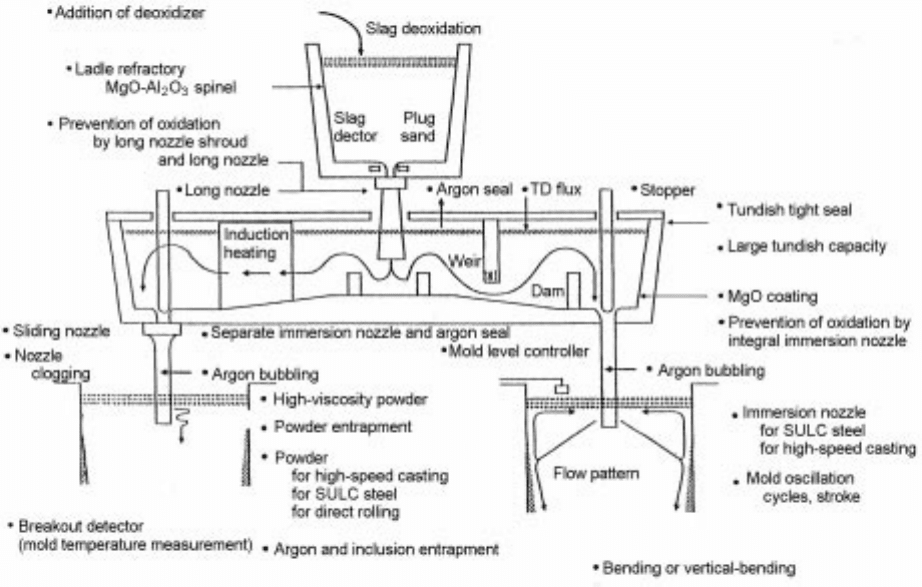Seetharaman S. Fundamentals of metallurgy
Подождите немного. Документ загружается.


greater sulfide and phosphate capacities. After more than a decade of industrial
campaign, the compositions of the fluxes seem to have converged into those
given in Table 13.6 mostly for cost reasons. To promote flux utilization for
removing P and S and minimizing heat loss, enhanced contact between the
fluxes and hot metal has been worked out in various designs of injection device
and vessel shape.
Utilization of a spare BOF for HMPT, where surplus BOF capacity exits, is
getting popular. The BOF provides (a) better slag±metal mixing without using
Table 13.5 Advantages and disadvantages of HMPT process
Advantages Disadvantages
1 Reduce BOF slag to a minimum
2 Reduce eruption of slag and metal
to near zero
3 Reduce iron loss in BOF slag
4 Reduce BOF blow time, increase
productivity
5 Increase hit rate at blow end of aim
C and temperature
6 Increase Mn yield from Mn ore
added in BOF
7 Reduce P, S to much lower
concentrations with hot metal low
in Si
·
Advanced sintering and BF iron
making techniques required to get
low Si hot metal consistently
·
Hot metal de-Si required
·
Occurrence of HMPT slag
·
Decreased use of scrap for BOF
Table 13.6 Characteristic operating parameters of HMPT process
Objective Reactor Flux addition Flux composition
1 Desiliconization BF runner Blasting with O
2
Ore/sinter
Tilting tundish ibid. ibid.
Transfer ladle
2 Desulfurization Transfer ladle Injection with N
2
Lime + Mg, or
Lime + CaF
2
/soda ash
Addition and ibid.
Mechanical
stirring
Torpedo Injection with N
2
ibid.
3 Dephosphoriza- Transfer ladle Injection with O
2
Lime + sinter/scale
tion and + CaF
2
/soda ash
desulfurization Torpedo ibid. ibid.
Spare BOF Addition and Lime + ore/sinter/
O
2
top blowing scale, partly recycled
Note: Use of CaF
2
and soda ash as fluxing reagent is limited to its minimum for environmental
aspect
526 Fundamentals of metallurgy

environmentally unfavorable CaF
2
for fluxing CaO and (b) decreased heat loss
due to shorter turnaround time s and recycling of a part of HMPT slag as hot. An
increase of scrap ratio up to some 15% has been estimated.
13
However, green
field installation of HMPT with the BOF is expensive. Thus, choice betwee n the
transfer vessel type and the BOF type for HMPT is a matter of compromise
between the increased investment and decreased running cost at higher scrap
rate with the environmental advantage.
HMPT in USA and Europe is limited to desulfurization with CaO-Mg
injection and the like into the transfer/charging ladle in order to save heat and
utilize more scrap in the BOF for cost reasons. Thus, choice o f HMPT is also a
trade-off between the abov e-mentioned advantages and disadvantages,
depending on local conditions.
Optimization of HMPT will develop as the demand grows for increased mass
processing of steel with improved properties and better lifecycle assessment. This
will be met in one way by reducing impurities to lower concentrations during high
speed refining. The obvious obstacle for implementing HMPT is the decrease in
the use of scrap in the BOF when the scrap has cost advantage. One way to
overcome the obstacle is to integrate the BOF, operating predominantly on hot
metal, and EAF, based on scrap but with hot metal heeling, into a steel works.
14
Regarding secondary refining, representative processes are shown in Figs 13.5
and 13.11.
7
LFs utilize enhanced contact of steel melt with top slag by use of
bottom Ar injection (and electromagnetic stirring) either under reduced pressu re
or mos tly at ambient pressure and in some cases with electric arc heating as shown
13.11 Secondary refining vessels (Morita and Emi).
7
Improving steelmaking and steel properties 527

13.12
A process integration for mass production of clean steel.
in Fig. 13.11. Top slag for Al-deoxidized steel melt is often CaO-Al
2
O
3
base slag
with high CaO activity that has low oxygen potential, high sulfide capacity and
good capability to dissolve oxide inclusions. For Al-Si- and Si-deoxidized steel
melt, it is CaO-SiO
2
base slag with low SiO
2
activity to decrease S, O, oxide
inclusions and minimize the occurrence of Al
2
O
3
rich inclusions. Simpler versions
of the LF, such as the CAS and CAS-OB are also in operation.
The RH utilizes vacuum vessel to cir culate steel melt as described in some
detail in the section on Process development to produce BH-1F SEDDQ steel
sheet, on page 511. Its major functi on is to decrease H, C, O and oxide
inclusions. Powder flux injection is made through the top lance (RH-PI) or side
tuyeres (RH-PB) of the vessel to reduce C and S to the order of single ppm as
already shown in Fig. 13.9. VOD is for high Cr steels, mostly stainless steels low
in C and N. Oxygen gas is soft blown on top of steel melt in the ladle placed in
the evacuated chamber, and the melt is decarburized to a very low concentration
without causing much oxidation loss of Cr.
In all processes, the intensive melt stirring function is implemented to enhance
mass transfer of impurities to reaction sites, i.e., gas±metal and/or slag±metal
interface, for efficient removal and homogenization of chemistry and temperature.
Process combinations effective in minimizing the majority of impurities are
shown in Fig. 13.12 for integrated iron and steel plants. It consists of HMPT (for
removing P and S or S), the BOF (C and some P), the LF (S, O and oxide
inclusions) and/or the RH (H, C, O and oxide inclusions). Tolerabl e limits of
impurities and non-metallic inclusions for typical high performance steels are
listed in Table 13.4. Ultimate levels of impurities commercially attainable by
best combinations of the above processes are given in Fig. 13.13.
14
The figure
shows that the level of each impurity is attainable if the process combination
concentrates on minimizing that specific impurity. The requirement on impurity
contents of high performance steels has become increasingly stringent. Measures
to meet the requirement have been industrialized, but more effort is needed to
make them more efficient, faster and economical.
13.2.2 Processes for controlling inclusions
Inclusions here include oxides and sulfides, carbides and nitrides. Control means
reduction of the total amount and maximum size and modification of chemistry
and morphology of the inclusions. Oxide inclusions occur indigenously and
exogenously in steel melt whereas others occur mostly in so lid steel
indigenously during solidification and cooling.
Indigenous oxide inclusions
Indigenous oxide inclusions occur from deoxidation of steel melt with deoxidiz-
ing alloys, mostly Fe-Si and Al, which combine with O to form silicates and
Improving steelmaking and steel properties 529

alumina particles. In steel melt deoxidized with Al, dissolved O becomes very
low (a few ppms with dissolved Al of a few hundred ppms), and deoxidation
product, solid Al
2
O
3
particles, is easy to remove by stirring the melt to let them
collide, agglomerate and surface to the meniscus. In reducing the amount of
oxide inclusions, inert atmosphere, and slag and refractory low in oxygen
potential, need to be utilized together with sufficiently strong stirring of steel
melt for the surfacing. Representative processes for this objective are the LF and
the RH as mentioned earlier.
However, suspended fine Al
2
O
3
particles tend to collide and agglomerate to
form large Al
2
O
3
clusters during melt transfer from ladle to mold even whe n
their O content is very small (e.g. only 1 ppm of O as alumina particles of 2 m
in diameter is equivalent to about 10
6
particles/cm
3
steel melt). The clusters
cause process upsets (i.e. break during deep drawing of sheet and drawing of
wire) and are detrimental for properties, if they have been caught in the
solidified steel shell. Also, clogging due to the deposi tion of the suspended
Al
2
O
3
on the inner wall of SEN during teeming for CC is not uncommon. The
deposit inhibits smooth teeming, resu lts in asymm etric melt flow out of SEN.
Such flow causes meniscus turbulence to entrain mold slag and penetrates deep
13.13 Minimum imp urity elements concentrations ach ieved on industrial
steelmaking and refining operation (Emi and Seetharaman).
14
530 Fundamentals of metallurgy
into the strand crater to prevent flotation of inclusions and entrained mold slag.
For steels where the cluster formation is critical, and sometimes for avoiding
the nozzle clogging, modification of inclusion chemistry from solid Al
2
O
3
to
liquid CaO-Al
2
O
3
has been prac ticed by adding Ca-alloy into the steel melt.
Dissolved Ca reacts with Al
2
O
3
, converting solid Al
2
O
3
into liquid lime
aluminates. Liquid lime aluminate inclusions are less prone to agglome rate, do
not form large cluste rs even when they agglomerate, merging into smaller
spheres. The spheres elongate during hot rolling, being fragmented into less
harmful fine pieces during cold rolling, and hence the proce ss upsets and
deterioration of properties can be avoided.
15
In an extreme case where Al
2
O
3
inclusion formation is strictly prohibited due
to upset in downstream processing, deoxidation is carried out with (insufficient
amount of Al) + Fe-Si or Fe-Si together with slag that is sufficiently low in silica
activity. Tire cord steel and valve spring steel are sensitive to break up during cold
drawing when Al
2
O
3
inclusions are left in the rod to be drawn. Accordingly, they
are deoxidized and inclusion controlled as mentioned above. Namely, dissolved O
content in equilibrium with Si of given concentration (for mechanical properties)
cannot be made low enough with Si-deoxidation. However, by the use of the
insufficient amount of Al prior to Fe-Si addition or use of the above slag with Fe-
Si, dissolved O can be decreased to reasonably low levels. Composition of the slag
is so chosen as to bring the composition of resulting inclusions in the melt falling
within the low temperature eutectic valley of pseudo-wollastonite and anorthite in
the ternary CaO-SiO
2
-Al
2
O
3
system. Also, composition of inclusions occurring
from solute segregation during solidification (without contacting the slag) should
be made to fall in the low melting temperature range of spessartite composition in
MnO-SiO
2
-Al
2
O
3
system.
16
These measures make the two inclusions plastically deformable during hot
rolling, and fragmented during the early stage of cold rolling, leaving only fine
independent pieces of the fragment at sufficiently long intervals of separation in
the steel for further cold working. This type of inclusion control is favorably
applied to high C steels, like tire cord and valve spring, that contain inherently
low equilibrium dissolved O in the melt before deoxidation, and hence suited for
Si deoxidation.
Exogenous oxide inclusions
Exogenous inclusions arise from (a) the reoxidation of deoxidized steel melt by
air and oxidizing slag and (b) entrainment of slag and refractory/ladle glaze
while the melt is carrie d over from ladle through tundish to mold. Exogenous
inclusions can be macroscopic in size (up to several hundred m), and hence
detrimental to every property of steels. To prevent the formation of macro
inclusions, measures have been taken to minimize the reoxidation and slag/
refractory/glaze entrainment, starting from the ladle and ending up at the mold.
Improving steelmaking and steel properties 531

Table 13.7 summarizes origin, cause and preventative measures of exogenous
macro inclusions. Typical examples of such system with the preventative
measures for metal transfer from ladle through tundish to mold is shown in Fig.
13.14.
17
Detailed discussion on this subject is available elsewhere.
18
Table 13.7 Origin, cause and preventative measures for the occurrence of macro
inclusions
Origin Cause Preventative measures
1 Oxidizing
ladle slag
·
Slag entrainment in melt by
vortex and drainage in later
stage of teeming
· Stiffening slag with MgO
· Leave some melt in ladle
· BOF tap hole slag stopper
· EAF-EBT
·
Reoxidation by top slag
and emulsified slag
· Slag deoxidation with Al
2 Reoxidation
by air
·
Air aspiration at loose joints
(ladle/long nozzle, slide
gate plates/tundish/SEN)
· Air tight packing with Ar seal
· Ar injection in tundish
nozzle/SEN
·
Air in tundish at transient
period
· Inertization of tundish inlet
with Ar flushing
3 Tundish
slag
·
Slag entrainment by vortex/
drainage while bath is
shallow
·
Large tundish with reasonable
depth and residence time
· Tundish furniture
·
Same by turbulent melt flow
at meniscus in transient
period
4 SEN
·
Clogging by alumina !
asymmetric aggressive melt
flow from SEN !
penetration of inclusions
deep into pool
· Ar injection from tundish
nozzle/SEN wall
· Fluid dynamic nozzle design
(annular, swirl type)
· Ca addition to melt, all to
· Dislodging of accretion reduce clogging
5 Mold slag · Slag entrainment by vortex · Electromagnetic meniscus
· Same by turbulent metal
flow at meniscus
flow control
· Optimization of throughput
rate and port angle of SEN
· Slag viscosity control
6 Indigenous,
exogenous
inclusions
· Large cluster formation of
suspending alumina
inclusions during melt
transfer into mold
· Large tundish, tundish
furniture
· Electromagnetic damping of
penetrating flow into melt
pool in strand
· Vertical bending caster
7 All sources · Same as for no. 6
532 Fundamentals of metallurgy

13.14
Tundish configuration effective to reduce macro inclusions and p
revent air reoxidation and slag entrainment during transfer of ste
el
melt from ladle to mold in continuous casting (Okimori).
17
Sulfide, nitride and carbide inclusions
Formation of coarse inclusions of sulfides (MnS), nitrides (TiN, VN) and
carbides (Cr
x
C
y
, TiC, NbC) can be reduced by refining S, N and C to a low
concentration and avoiding the incorporation of compound-forming partner
elements, Mn, Cr, Ti, Nb, and V to the melt whenever appl icable. The limitation
is that some of the above elements and compounds are used as beneficial
components to improve properties. Thus, chemic al composition of steel
materials is to be optimized to avoid the occurrence of these compounds in
harmful sizes and amounts.
When the melt is cast into CC strands, however, solute segregation takes
place in the remaining melt as solid fraction in the strand increases with time.
Finally, near the center thickness of the strands, the concentration of solutes in
the melt, typically C, P and S, becomes excessively high or exceeds solubility
products to form precipitates because the partition coefficient, C
s
/C
l
, for these
elements is less than unity. The solute segregation, whether it is with or without
the precipitates, is called center segregation for billets and blooms and centerline
segregation for slabs.
The center/centerline segregations can be reduced, as mentioned in Section
13.2.2, by:
(a) Increasing the sedimentation of solute-lean equiaxed crystals of steel in the
vicinity of the pool end in CC strand.
(b) Dispersing solute enriched melt between the sediment crystals.
(c) Preventing suction, that is caused by shrinkage on solidification and/or
bulging of the strand shell, of the solute-enriched interdendritic melt in the
columnar dendrite crystal zone into the thin layer of the pool end at center
thickness.
To increase the sedimentation of equiaxed crystals, casting is made at
reasonably low superheat temperatures with electromagnetic stirring (EMS) of
melt in the mold. Low superheat and EMS enhance nucleus formation and
growth of the equiaxed crystals to near the end of the melt pool. EMS near the
pool end disperses the solutes enriched interdendritic melt among equiaxed
crystal boundaries. To prevent the suction, bulging of strand is not tolerated, and
hence alignment and profile of support rolls should be precisely maintained. In
addition, squeezing of solute-enriched melt out of the pool end is performed by
soft reduction of the strand near the pool end by support roll pairs to surpass
solidification contraction. A bloom caster equipped with electromagnetic stirrer
and soft reduction roll pairs is shown in Fig. 13.15
19
that is effective to produce
blooms without appreciable center segregation of solutes. This also applies to
slab casters.
534 Fundamentals of metallurgy

13.3.3 Integrated optimization of refining, casting, rolling and
heat treatment for better properties and productivity
In modern steel mills, processes are interconnected to make steel flow as
continuous as possible to achieve maximum productivity and premium yield at
minimum cost and delivery time. Optimization of properties vs productivity is
pursued through all processes, from raw material preparation, ironmaking, to
surface finishing. Only property-related subjects will be mentioned in the
following listing.
In the ironmaking sector, major issues are to keep up stable production of hot
metal with designated chemistr y and temperature while pursuing reduction of
energy consumption and CO
2
emission in spite of degrading ore and coal.
In the steelmaking and refining sector, the optimization measures include:
(a) Separating refining function of P and S from the BOF/EAF to HMPT and
the LF, making the BOF/EAF to be more or less a decarburizing furnace.
When HMPT covers dephosphorization and desulfurization of hot metal, Si
in hot metal is decreased to its minimum. This minimizes lime addition and
hence slag evolution, eruption and iron loss and maximizes Mn reduction
from the Mn ore in the BOF as discussed in the previous section.
(b) Development of the high speed blow and low slag process in the large size
combined blown BOF (top O
2
blow + bottom Ar injection for stirring) with
dynamic blow control followed by direct tapping. The objectives are to
maximize productivity and metal yield and minimize over-oxidation of steel
and slag melt and carry-over of slag into the ladle.
13.15 Bloom caster with electromagnetic stirrer in mold and soft reduction rolls
at pool end to reduc e segregation of solute elements in the center of bloom
(Isobe et al.).
19
Improving steelmaking and steel properties 535
